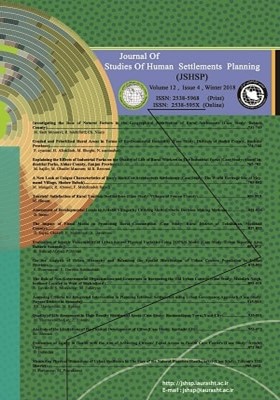Studying the Integrated Resilience Model and the Socioeconomic Physical Structure of Langrud City Against Environmental Hazards
Subject Areas : Natural geography and human settlements
sanam mirhaghisaatchi
1
*
![]() ,
Abbas Kangi
2
,
عبدالرضا جعفریان
3
,
Abbas Kangi
2
,
عبدالرضا جعفریان
3
1 -
2 - Geology, Structural Geology and Tectonics, Shahrood islamic Azad university
3 - زمین شناس
Keywords: Resilience, physical structure, socio-economic, natural hazards,
Abstract :
Introduction: The city of Langarud, due to its geographical location, is exposed to environmental hazards, particularly earthquakes. Since cities possess both physical and spiritual aspects, examining their resilience against these hazards is essential to enhance the resilience of both human-made and natural systems.
Objective: This study aims to investigate the integrated model of resilience and the socio-economic and physical structure of the city of Langarud against environmental hazards caused by earthquakes.
Research Methodology: This non-experimental research is of a correlational type. It is an applied study with a cross-sectional time frame. The research was conducted in the field and utilized both library resources and documentary methods.
Geographical Scope of the Study: This research was conducted in the city of Langarud, an important city in Gilan Province, northern Iran.
Findings: Data processing was based on examining models of safety index parameters, estimating earthquake damages to buildings using the WARED system, assessing economic geology, and considering peak ground acceleration (PGA), which is the most critical seismic parameter.
Results:. The results indicate that by examining the fragility curves extracted from the HAZUS project, the city of Langarud is reasonably resilient in terms of its socio-economic and physical structure against environmental hazards, particularly earthquakes
KEYWORDS: Resilience, physical structure, socio-economic, natural hazards
1. Azmudeh Ardalan, Alireza, Fortun, Ehsan and Agha Mohammadi, Hossein (2016). Spatial Modeling to Reduce Earthquake Damages, Proceedings of the First Conference on Dealing with Natural Disasters, Scientific Pole of Mapping Engineering, Technical Campus of Tehran University.(in Persian)
2. Ahmadi, Esmail, Hejazizadeh, Zahra, Alijani, Bahloul, Sasif, Mohammad, Danaei Fard, Hassan (2014). Calculation of climate vulnerability index based on multiplicative-exponential model of Sistan and Baluchistan Province, Applied Research Journal of Geographical Sciences, 15 (36): 73-96. .(in Persian)
3. Bahraini, Seyyed Hassan (2017). Land use planning in earthquake-prone areas (case example: Lushan, Manjil and Rudbar cities). Tehran: Center for dealing with all kinds of natural disasters in Iran .(in Persian)
4. Abdulahi, Majid (2011). "Crisis Management in Urban Areas", Tehran, Anwar Publications .(in Persian)
5. BÉNÉ, C. (2013). Towards a quantifiable measure of resilience. IDS WORKING PAPER, Volume 2013 ,Number 434,1-27. Retrieved from: http://onlinelibrary.wiley.com/doi/10.1111/j.2040- 0209.2013.00434.x/full
6. BERKE, P. & GLAVOVIC, B. (2012). Ecosystems and Disaster Resiliency: Contributions to a Holistic Theory of Recovery. International Journal of Mass Emergencies and Disasters, 30, 182-196. Retrieved from: http://www.ijmed.org/ articles/600/download/
7. Behtash Mohammad Reza; Kaynejad, Ali; Pir Babaei, Mohammad Taghi; Askari, Ali (2012). Evaluation and analysis of dimensions and resilience components of Tabriz metropolis. Journal of Fine Arts - Architecture and Urbanism 18, (3), pp. 33-43 Retrieved from https://journals.ut.ac.ir/article_51316_4713.html. .(in Persian)
8. CONSTAS, M. & BARRETT, C. (2013). Principles of resilience measurement for food insecurity: metrics, mechanisms, and implementation plans. Expert Consultation on Resilience Measurement Related to Food Security, Food and Agricultural Organization and World Food Program, Rome, Italy. Retrieved from: www.fao.org/fileadmin/user_upload/ drought/docs/FSIN%20Resilience%20Measurement%20 201401.pdf
9. Norris, F. H., Stevens, S.P., Pfefferbaum, B., Wyche, K.F., & Pfefferbaum, R.L. (2008) Community Resilience as a Metaphor, Theory, Set of Capacities, and Strategy for Disaster Readiness. Am J Community Psychol, 41, 127–150
10. ROSE, A. & KRAUSMANN, E.(2013). An economic framework for the development of a resilience index for business recovery. International Journal of Disaster Risk Reduction, 5, 73-83. Retrieved from: http://www.sciencedirect.com/ science/article/pii/S221242091300040X
11. Rezaei, Mohammad Reza. (2012). Economic and institutional resilience in urban communities against environmental hazards. Two scientific and research quarterly journals of crisis management (3), 25-40. .(in Persian)
12. Rafiyan, Mojtaba; Rezaei, Mohammad Reza; Askari, Ali; Parhishkar, Akbar; Shayan, Siavash (2009). Conceptual explanation of resilience and planning and (CBDM) indexing in community-based disaster management, space planning and preparation, Modares Human Sciences, 15 (4), pp. ÷9-4÷41. Recover from
13. http://fa.journals.sid.ir/ViewPaper.aspx?id=170456. .(in Persian)
14. Ramzanzadeh, Mehdi and Badri, Seyyed Ali (2015). Explanation of the socio-economic structures of resilience of local communities against natural disasters with an emphasis on floods (case study: tourism basins of the Kileh Tankabon spring and the cold water of the Kalardasht river), Geography Quarterly, Volume, 12, No. 40, pp. 109-131. .(in Persian)
15. Roostaee, Mojtabi, Ebrahimzadeh, Isa and Istgoldi, Mustafa, (2016). Analysis of physical resilience against earthquakes: a case study of the worn fabric of the border city of Zahedan, Journal of Geography and Development, 46 (1): 1-18. .(in Persian)
16. Rose, A. (2004). Defining and measuring economic resilience to disasters. Disaster Prevention and Management, 13, 307-314.
17. Richard Lightner (2004). Hawaiian History: An Annotated Bibliography. Greenwood Publishing Group. p. 141. ISBN 978-0-313-28233-1.

